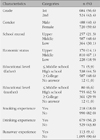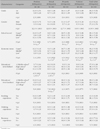Abstract
Purpose
The purpose of this study was to explore gender-role identity and cyber delinquency in high school students.
Methods
Data were collected through self-administered questionnaires and analyzed by descriptive statistics, t-test, and ANOVA. The data survey was conducted with 1,208 conveniently selected high school students in Seoul, Gyung-gi and Chung-chung province.
Results
The cyber delinquency score was 38.94 and androgyny gender role identity was most common (34.0%). There were significant differences in cyber delinquency by academic year, gender, school record, economic status, educational background of parents, experiences of smoking, drinking, runaway, and gender-role identity. According to gender-role identity, the masculinity group showed highest cyber delinquency and the undifferentiated, androgyny, and femininity groups followed respectively.
Figures and Tables
References
2. Boldizar JP. Assessing sex typing and androgyny in children: The children's sex role inventory. Dev Psychol. 1991; 27:505–515.

3. Byun MS. The effects of parents' gender roles and child-rearing practices on children's masculinity and femininity. Seoul: Chung-Ang University;2004. Unpublished doctoral dissertation.
4. Cheong K, Kwon R. The relationships between parental and teacher attachment and juvenile delinquency: An empirical test of general strain theory. Korean J Youth Stud. 2006; 13(5-2):81–102.
5. Choi IS, Kim CH. The effects of sex-role identity upon school adjustment behavior. Korean J Educ Psychol. 2004; 18(1):131–143.
6. Choi HR. Parental attachment, automatic thoughts, gender role identity as variables affecting adolescent aggression. Korean J Couns Psychother. 2005; 17(3):599–616.
7. Han JW. A study about social bond variables of cyber delinquency adolescent. Korean Assoc Police Sci Rev. 2001; 3:354–384.
8. Hirch T. Causes of delinquency. Berkely, CA: University of California Press;1969.
9. Holt CL, Ellis JB. Assessing the current validity of the sex-role inventory. Sex Roles. 1998; 39(11):929–941.
10. Jang HS, Han GH, Jun WJ. Attachments to parents and gender-role identity. J Dev Psychol. 2002; 15(3):93–108.
11. Kim DK, Jeon JY, Lee SJ. Tests of the mediating effect of stress and aggression in the relation between juvenile leisure constraint and cyber delinquency. Korean J Youth Stud. 2008; 15(5):157–179.
12. Kim JH, Kim KS. The relationship of psychological variances and internet addiction tendency, cyberrelated delinquency in adolescence. J Adolesc Welf. 2003; 5(1):85–97.
13. Kim KS. The parents-related factors prediction models for internet game addiction of adolescence. Seoul: Chung-Ang University;2009. Unpublished doctoral dissertation.
14. Kim SJ. A study on correlation between teenager's consciousness of telecommunication ethics and cybercrimes. J Adolesc Welf. 2004; 6(1):69–88.
15. Kim YH. A study of the influence of family environment on juvenile delinquency. Seoul: University of Seoul;2007. Unpublished master's thesis.
16. Kong EH. Differences in the levels of internet use and internet addiction types in accordance with sex role identity among adolescents. Daegu: Keimyung University;2002. Unpublished master's thesis.
17. Lee BS, Kim MA, Koh HJ. Development of Korean gender role identity inventory. J Korean Acad Nurs. 2002; 32(3):373–383.

18. Lee SS. Sex differences of juvenile crimes in paternalistic family. Korean J Criminol. 1999; 11:207–235.
19. Lim U, Sea H. Gender role identity and juvenile delinquency: an empirical test of social control theory. Korean J Youth Stud. 2007; 14(3):53–78.
20. Ra MO. The relationship of impulsivity, internet addiction tendency, and cyber-related delinquency in adolescence. Kangneung: Kangwon National University;2001. Unpublished master's thesis.
21. Ryu EJ, Seo JS, Ham MY, Park YR, Moon SW, Nam BW. Sex-role identity in adolescents and its relation to anxiety, depression and suicidal ideation. J Korean Acad Psychiatr Ment Health Nurs. 2006; 15(2):136–143.
22. Shover N, Norland S, James T, Thornton WE. Gender roles and delinquency. Soc Forces. 1979; 58(1):162–175.

23. Sohn JN. A relationship among sexual contact, sex role identity, and self esteem of girls' high school students. J Korean Community Nurs. 2003; 14(3):468–478.
24. Wang GH, Kim J. Children's gender role identity according to parental childrearing Behavior and children's self-esteem. J Fam Relat. 2009; 13(4):49–73.
25. Yeom YR. Factors influencing internet addiction in high school students. Gwangju: Chonnam National University;2007. Unpublished master's thesis.
26. Yoo KH. Sex-role development in late childhood and adolescence: Relationships among sex-role stereotypes, sex-role ideology, sex-role identity, and self-esteem. Korean J Child Stud. 1994; 15(1):127–144.
27. Yoo WY. The relationship of the children's sex-role identity and self-esteem. Gwangju: Chonnam National University;1992. Unpublished master's thesis.




 PDF
PDF ePub
ePub Citation
Citation Print
Print







 XML Download
XML Download